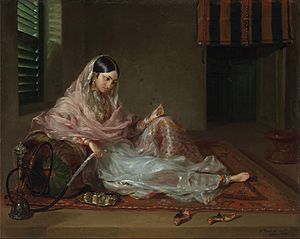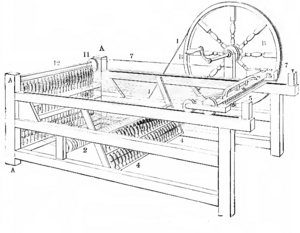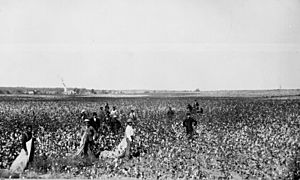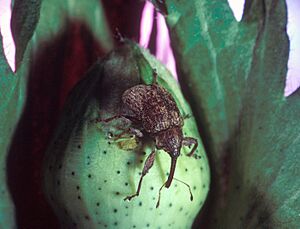History of cotton facts for kids
The story of cotton is a long one, going back thousands of years! It's about how this plant became super important for clothes and trade all over the world, from India to the British Empire and the United States.
People in different parts of the world learned to grow cotton and turn it into fabric on their own. They even invented similar tools like combs, hand spindles, and simple looms to work with it.
Cotton has been used by humans for a very long time. We've found cotton fabrics from ancient times in India, Egypt, and Peru. The cotton industry was a huge part of the American economy, especially before the Civil War, when it made a lot of money for slave owners in the southern United States. Today, cotton is still a major crop worldwide, with China and India growing the most.
Contents
What's in a Name?
The word "cotton" comes from the Arabic word "qutn." This was the common word for cotton in the Middle Ages. It made its way into European languages in the 1100s and into English about a hundred years later. The ancient Romans knew about cotton, but it was quite rare in Europe until more of it started coming from Arabic-speaking lands.
Cotton's Ancient Roots
The oldest cotton fabrics have been found in dry places, like old graves and city ruins, where they didn't completely rot away.
Cotton in America
The very oldest cotton fabric was found in Huaca Prieta in Peru, dating back to about 6000 BCE (that's 8,000 years ago!). This is where a type of cotton called Gossypium barbadense might have first been grown. Some old cotton bolls (the fluffy part of the plant) were found in Mexico from around 5500 BCE. By 3000 BCE, people in Mexico and Arizona were growing and processing cotton.
Cotton in the Kingdom of Kush
Cotton might have also been grown in eastern Sudan around 5000 BCE. People in the ancient city of Meroë were very skilled at spinning and weaving cotton by the 300s BCE. Selling textiles was a big source of wealth for Meroë.
Cotton in India
The newest discoveries show that cotton was grown and used in Mehrgarh, India, as early as 5000 BCE. The Indus Valley civilization started growing cotton by 3000 BCE.
Herodotus, an ancient Greek historian, wrote about Indian cotton in the 400s BCE. He called it "wool exceeding in beauty and goodness that of sheep," which means Greeks probably didn't know about cotton yet. When Alexander the Great invaded India, his soldiers started wearing cotton clothes because they were more comfortable than their woolen ones.
Cotton in the Middle Ages
Eastern World Cotton Tools
Simple roller cotton gins, which help separate cotton fibers from seeds, were used in India since the 500s CE. They then spread to other countries. Between the 1100s and 1300s, gins with two rollers appeared in India and China. The Indian two-roller gin became common in the Mediterranean cotton trade by the 1500s. Some of these machines were even powered by water!
Western World Cotton Trade
Egyptians were growing and spinning cotton from 600 to 700 CE.
Cotton was a common fabric during the Middle Ages and was woven by hand. Cotton making came to Europe when Muslims conquered parts of Spain and Sicily. The knowledge of weaving cotton spread to northern Italy in the 1100s and then to the rest of Europe. The spinning wheel, which arrived in Europe around 1350, made spinning cotton much faster. By the 1400s, cities like Venice and Antwerp were important places for trading cotton, and selling cotton fabrics became very profitable.
When Christopher Columbus explored the Bahamas and Cuba, he saw native people wearing cotton clothes. This might have made him think he had reached India.
Cotton in the Early Modern Period
India's Cotton Dominance
India had been selling fine cotton fabrics to other countries for a very long time. Travelers like Marco Polo (in the 1200s) and Vasco Da Gama (in 1498) praised the amazing quality of Indian fabrics.
The "churka" cotton gin, which used a special screw-like gear, was used in India between the 1200s and 1600s and is still used there today. Adding a crank handle to the churka made it even better. The spread of the spinning wheel across India before the Mughal era helped lower the cost of yarn and increased the demand for cotton. These improvements greatly boosted Indian cotton textile production during the Mughal Empire.

From the early 1500s to the early 1700s, India's cotton production grew a lot. The Mughal rulers made changes that encouraged growing valuable crops like cotton.
The biggest manufacturing industry in the Mughal Empire was cotton textile manufacturing. This included making different types of fabrics like calicos and muslins. India had a huge share (25%) of the global textile trade in the early 1700s. Indian cotton textiles were the most important manufactured goods traded worldwide in the 1700s. The Bengal Subah province, especially around its capital city of Dhaka, was the most important center for cotton production.
Bengali cotton textiles were sent in large amounts to Europe, Indonesia, and Japan. Indian textiles were traded across the Indian Ocean for centuries and even sold in the Atlantic Ocean trade.
Europe's Growing Demand
Cotton cloth became very popular in European cities during the Renaissance and the Enlightenment. Vasco da Gama opened up sea trade with Asia, which made it easier to transport heavy goods like cotton. Indian craftspeople had kept the secret of making colorful patterns for a long time. But a French priest, Father Coeurdoux, learned their process and shared it in France, which helped the European textile industry.
In early modern Europe, there was a big demand for cotton textiles like chintz from Mughal India. From the late 1600s to the early 1700s, Mughal India provided 95% of what the British bought from Asia. However, Europeans had little to sell to India, so they had to send large amounts of gold and silver to pay for Indian goods.
Egypt's Cotton Industry
In the early 1800s, Egypt under Muhammad Ali had one of the most productive cotton industries in the world. At first, it used traditional power sources like animals and water wheels. But under Muhammad Ali, steam engines were brought into the Egyptian cotton industry.
Cotton in the British Empire
Cotton became super important in Europe because of big changes in culture and Britain's trading empire. Types of cotton fabrics like calico and chintz became popular in Europe. By 1664, the East India Company was bringing in a quarter of a million pieces of cotton cloth to Britain.
By the 1700s, people wanted fabrics that were easy to wash and colorful. Cotton prints became popular. However, in 1721, the British Parliament passed the Calico Act to ban calicoes because they threatened British manufacturers. This act was later removed in 1774 when new machines allowed British factories to compete.
Indian cotton textiles were still very good until the 1800s. To compete with India, Britain developed new machines that saved labor. They also put in place rules like bans and tariffs (taxes on imports) to limit Indian goods. At the same time, the East India Company's rule in India opened up a new market for British goods. Britain also imported raw cotton from India without taxes, giving it control over India's large market and cotton. Britain eventually became the world's top cotton textile maker in the 1800s.
The cotton industry grew a lot under the British Empire. British cotton products sold well in Europe. Britain also traded successfully with its own colonies. As the cotton industry grew, manufacturers needed more raw cotton. So, cotton farming expanded to places like West India.
Cotton in Britain

Cotton was very versatile. It could be mixed with linen or made into velvet. It was cheaper than silk and easier to print patterns on than wool. Cotton became the popular fashion and was affordable for most people. New inventions in the 1770s—like the spinning jenny, the water frame, and the spinning mule—made the British Midlands a very profitable manufacturing area.
The textile mills in Lancashire were a huge part of Britain's Industrial Revolution. Workers in these mills often had very tough conditions: low pay, child labour, and long workdays (sometimes 18 hours). Richard Arkwright built a factory system powered by water. In the 1790s, James Watt's steam power was used for textile production. By 1839, thousands of children worked in Manchester's cotton mills. Child labor was banned in the mid-1800s.
Cotton in the United States
Before the Civil War
In the early 1790s, fighting between Britain and France meant that the United States became an important buyer of British cotton goods. In 1791, the U.S. didn't produce much cotton. But several things helped the industry grow: more demand from Britain, new inventions in spinning and weaving, cheap land, and a workforce of enslaved people.
The modern cotton gin, invented in 1793 by Eli Whitney, greatly boosted the American cotton industry. Before this, removing seeds from cotton by hand was very slow. The cotton gin made cotton the main crop in the South, even more important than tobacco. By 1801, the U.S. produced over 22 million kilograms of cotton each year. By the early 1830s, the United States produced most of the world's cotton. Cotton also became more valuable than all other U.S. exports combined.
Growing cotton using enslaved Africans and their descendants brought huge profits to plantation owners, making them very wealthy. In states where slavery was not allowed, farms usually stayed small because there weren't enough workers. But in slave states, owners could buy many enslaved people and farm huge areas of land. By the 1850s, enslaved people made up half the population in the main cotton states like Georgia, Alabama, Mississippi, and Louisiana. Having an unpaid workforce was the most important part of growing cotton. This is why the cotton industry played a big role in the Southern upper class supporting slavery.
Cotton's importance in the U.S. economy and worldwide led Senator James Henry Hammond to famously boast in 1858 about "King Cotton":
Without firing a gun, without drawing a sword, should they make war on us, we could bring the whole world to our feet... What would happen if no cotton was furnished for three years?... England would topple headlong and carry the whole civilized world with her save the South. No, you dare not to make war on cotton. No power on the earth dares to make war upon it. Cotton is king.
This idea, called Cotton diplomacy, was that cotton would make Britain and France help the South in the Civil War. But it didn't work. The Civil War did cause the Lancashire Cotton Famine (1861-1865), a tough time for the British cotton industry, because American raw cotton was blocked.

Before the Civil War, British companies looked for new places to grow cotton in case the war stopped American exports. India was seen as a good option. India did help fill the gap during the war, providing a lot more cotton to Britain.
After the Civil War
After the American Civil War ended in 1865, British and French traders went back to buying cheap American cotton. This caused problems for Egypt, which had been supplying cotton during the war.
The South continued to rely heavily on cotton until the 1900s, when the boll weevil insect caused major damage. Many former enslaved people and poor white people worked in a system called sharecropping, which was very difficult.
Cotton in Spain
Cotton textile production in Spain was mainly in Catalonia. By the mid-1800s, Catalonia became Spain's main industrial region.
This industry started in the early 1700s when printed cloth called chintz was made in Barcelona. This was helped by the government banning imported chintz from India and opening up trade with Spain's American colonies. Later, in the early 1800s, English spinning technology was brought in. Factories started using steam power in the 1830s. However, because coal and steam engines were expensive to import, factories started using water power more from the late 1860s. This led to many "industrial colonies" being built along rivers in rural Catalonia, where they could use water power and find cheaper labor and land.
From the mid-1800s, the industry was increasingly protected (meaning the government helped it) because it was hard for Spain to compete globally due to the costs of importing raw cotton, energy, and machines. The industry declined during the Great Depression and after the Spanish Civil War, as Spain's economy struggled.
Cotton's Modern Story
The Boll Weevil Problem
Boll weevils, which are tiny insects that eat cotton, entered the United States from Mexico in 1892. They caused problems for the U.S. cotton industry for 100 years! Many people think the boll weevil was almost as important as the Civil War in causing changes in the South. It's estimated that boll weevils caused $22 billion in damages.
In the late 1950s, the U.S. cotton industry faced economic problems, and getting rid of the boll weevil became a top priority. Scientists developed traps and special scents to detect them. The program was successful, and the use of pesticides went down a lot as the boll weevil was removed from some areas.
Cotton in Africa and India Today
After the Cotton Famine, European textile makers looked for new places to get raw cotton. African colonies like West Africa and Mozambique provided a cheap supply. Taxes and other rules discouraged local textile production in these areas. Working conditions were very harsh, especially in places like the Congo. This led to some revolts and a black market for local textiles.
More recently, United States government payments to cotton farmers have made world prices lower. This makes it hard for African farmers to compete.
India's cotton industry struggled in the late 1800s because its production wasn't mechanized, and America dominated raw cotton exports. India stopped being a major exporter of cotton goods and became the biggest buyer of British cotton textiles.
Mohandas Gandhi believed that cotton was very important for India's independence. In the 1920s, he started the Khadi Movement, a huge boycott of British cotton goods. He urged Indians to use simple, homemade cotton textiles called khadi. Cotton became a strong symbol in the Indian independence movement. During World War II, there was a high demand for khadi. The British rulers said khadi was dangerous and tried to stop it, but this only made people resist more. In the second half of the 1900s, as the European cotton industry declined, India's cotton industry grew again. India started using machines and was able to compete in the world market.
Decline of British Cotton Industry
In 1912, the British cotton industry was at its best. But during World War I, cotton couldn't be sent to other countries, and some countries, especially Japan, built their own factories. By 1933, Japan was producing cotton 24 hours a day and became the world's largest cotton manufacturer. Demand for British cotton dropped.
India's boycott of British cotton products hit places like Lancashire very hard. In Blackburn, 74 mills closed in less than four years.
During World War II, the British cotton industry saw a temporary boost as Lancashire mills made parachutes and uniforms for the war.
In the 1950s and 60s, many workers from the Indian subcontinent came to Lancashire to work in the mills. This helped for a while, but by 1958, Britain was buying more cotton cloth than it was making.
By the 1960s and 70s, a mill in Lancashire closed almost every week. By the 1980s, the textile industry in North West Britain had almost disappeared.
Cotton in Today's Economy
Textile mills have moved from Western Europe to places where wages are lower, like India, Bangladesh, China, and Latin America. In these regions, labor is much cheaper, which attracts workers.
Biotechnology is important in cotton farming today. There's genetically modified cotton that can resist certain herbicides and repel insects. Organically grown cotton is becoming less common compared to synthetic fibers made from petroleum.
The demand for cotton has doubled since the 1980s. As of December 2016, India is the main producer of cotton (26%), followed by China (20%) and the United States (16%). The U.S. is the top exporter of cotton, and its production is supported by government money. The value of cotton has been going down for sixty years.
Max Havelaar, a fair trade group, launched a fair trade label for cotton in 2005. This helps small farmers from places like Cameroon, Mali, and Senegal get a better price for their cotton and ensures fair working conditions.
Images for kids
-
Cotton sheds and merchants in Bombay (1850s-70s) by Francis Frith
-
Cotton merchant in Bombay (1850s-70s) by Francis Frith
See also
 In Spanish: Historia del algodón para niños
In Spanish: Historia del algodón para niños







